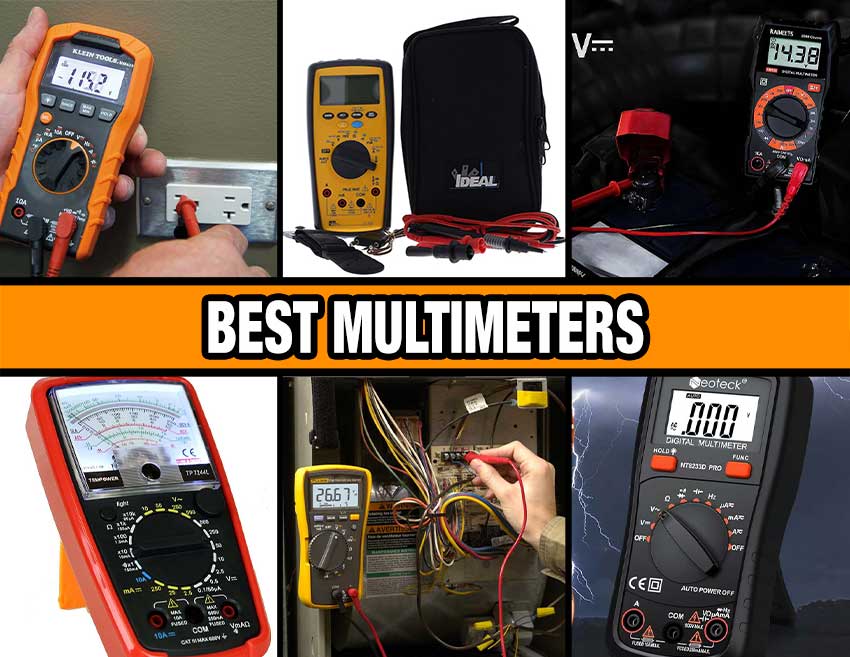Multimeters are essential tools for electricians, HVAC professionals, and electronics technicians, as well as handy solutions for homeowners. However, there are loads of them on the market. Indeed, the sheer number of manufacturers, models, and prices can make choosing the best multimeter a tough task.
With that in mind, we’ve assembled some of the top multimeters in 2024 for professionals and DIYers. Whether you’re an electrician or a homeowner, our guide will walk you through everything you need to know before you buy!
- Best Overall: Milwaukee Digital Multimeter 2216-20 – Buy from Home Depot
Jump to this Multimeter ↓ - Best Budget: Kaiweets Digital Multimeter KM100 – Buy on Amazon
Jump to this Multimeter ↓ - Best Analog: Tekpower Analog Multimeter TP7244L – Buy on Amazon
Jump to this Multimeter ↓ - Best for Home Use: Klein Tools Multimeter MM400 – Buy on Amazon
Jump to this Multimeter ↓ - Best Fluke: Fluke 117 Multimeter – Buy from Acme Tools
Jump to this Multimeter ↓ - Best Clamp On: Fluke 302+ 400AC Clamp Meter – Buy on Amazon
Jump to this Multimeter ↓ - Best for Electricians: Ideal Electric Commercial Multimeter 61-357 – Buy on Amazon
Jump to this Multimeter ↓ - Best for HVAC: Fluke 116 HVAC Multimeter – Buy from Acme Tools
Jump to this Multimeter ↓ - Best for Cars & RVs: AstroAI Digital Multimeter AM33D – Buy on Amazon
Jump to this Multimeter ↓ - Best for Beginners: Neoteck Pro Auto Ranging Digital Multimeter NT8233D – Buy on Amazon
Jump to this Multimeter ↓
Also In This Article
- How We Picked the Best Multimeters
- Best-Selling Multimeters
- Best Multimeters Buying Guide
- Frequently Asked Questions about Multimeters
- Why You Can Trust Pro Tool Reviews
Related Content
- How to Use a Multimeter
- Electrical Testing Tools You Need to Have
- Top 10 Electricians Tools You Need as an Apprentice
- What Are Electrical Measurement Categories?
How We Picked the Best Multimeters
When choosing multimeters for this list, we considered all the different multimeter applications. We include models with the functions and safety features to best meet the needs of a variety of professionals who use these devices daily, including electricians, auto mechanics, and HVAC technicians. Along with these pricier professional-grade models, we also included models that meet the needs and budget of the average homeowner.
Best Overall
Milwaukee Digital Multimeter 2216-20
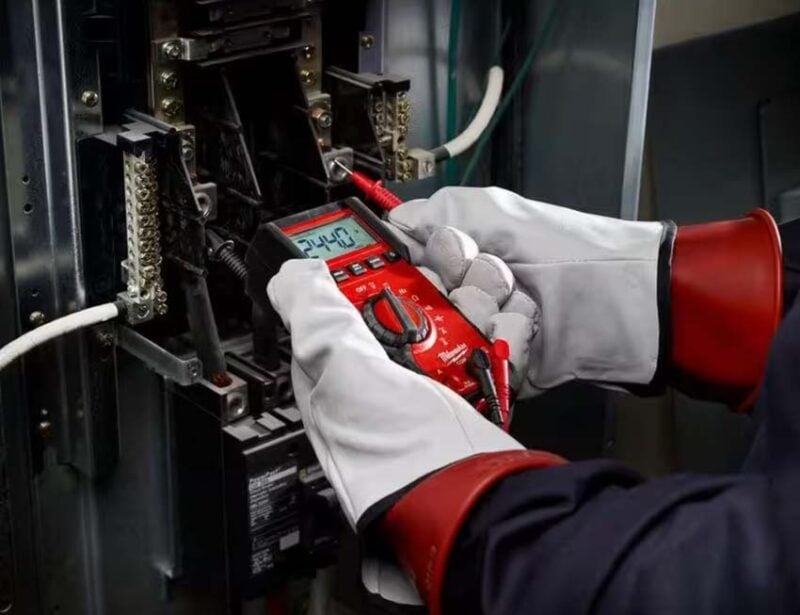
Milwaukee’s take on the digital multimeter checks all the boxes with a few notable extras. It has a range of 600 volts, is auto-ranging in millivolts, can measure frequency, has true RMS to prevent false readings, and is capable of measuring capacitance up to 1,000 degrees Fahrenheit. Milwaukee’s digital multimeter is also one of the more ruggedly designed multimeters with a rubberized cover around its exterior. We also like the large easy-to-read display that includes a backlight you can turn on and off and the design of the buttons and dial. This multimeter also gives you audible and visual alerts when it senses live voltage. While Milwaukee’s multimeter comes with a high price tag, it’s worth it if your job requires one.
KEY FEATURES:
- True RMS prevents ghost readings
- Rugged molded rubber exterior
- Auto-ranging in millivolts
- Easy-to-read backlit display
SPECIFICATIONS:
- Max Voltage: 600 volts
- Automatic Ranging: Yes
- Safety rating: CAT III 600V
Price: $179.99
Best Budget Multimeter
Kaiweets Digital Multimeter KM100
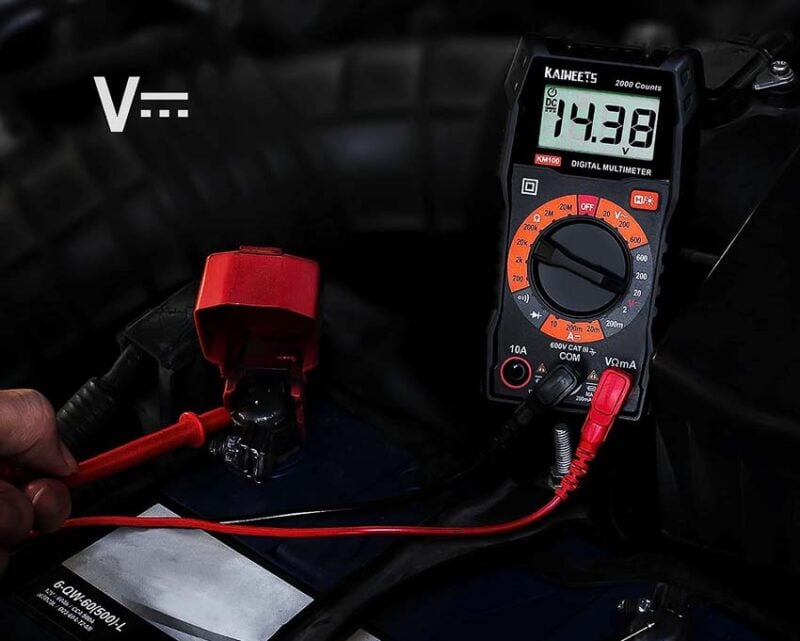
If you need a multimeter for at-home use now and again, then there’s no point shelling out $40 or more for one. While it may lack features found on pricer models, such as auto range, and the ability to test AC current, this multimeter from Kaiweets will handle most household multimeter needs and costs just a fraction of other multimeters. You can test AC/DC voltage, DC current, resistance, continuity, and diodes. It also has safety features, including overload protection and built-in fuses, which make it a great pick for novices.
KEY FEATURES
- Overload protection and built-in fuses
- Test continuity and diodes
- Includes test probes and carrying case
SPECIFICATIONS
- Max Voltage: 600 volts
- Automatic Ranging: No
- Safety rating: CAT III
Price: $12.79
Best Analog Multimeter
Tekpower Analog Multimeter TP7244L
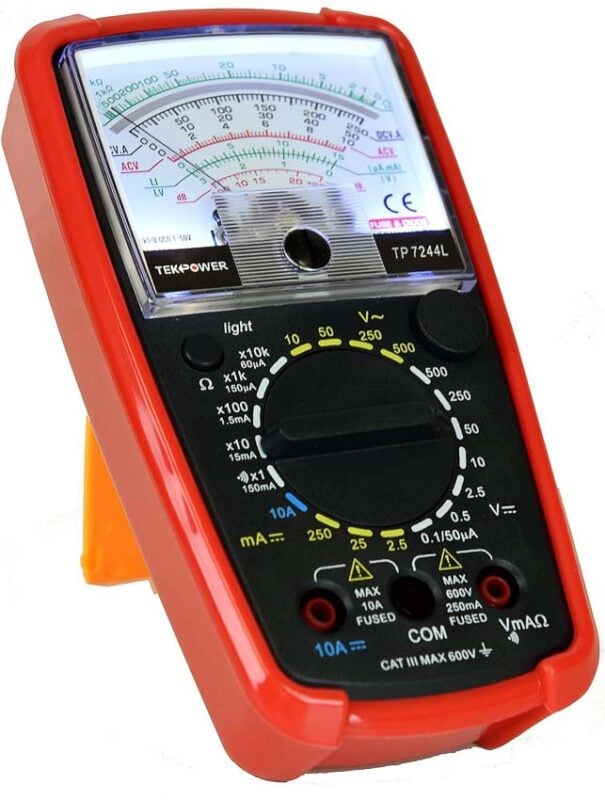
While digital models may dominate the multimeter market, there are still some applications in which an analog model works best. For those, go with this multimeter for Tekpower. It gives you the ability to measure voltages, current, resistance, continuity, decibel values, and test diodes. There’s also a mirror behind the needle that helps eliminate false readings from parallax, a common problem with analog multimeters. We also like the tough build quality of this multimeter, which features a rubberized cover that protects the entire case, and the built-in backlight that makes the display easier to read in dark places.
KEY FEATURES
- Built-in mirror for accurate readings
- Durable construction
- Can measure a broad range of values
SPECIFICATIONS
- Max Voltage: 600 volts
- Automatic Ranging: No
- Safety rating: CAT II
Price: $34.98
Best Multimeter for Home Use
Klein Tools Multimeter MM400
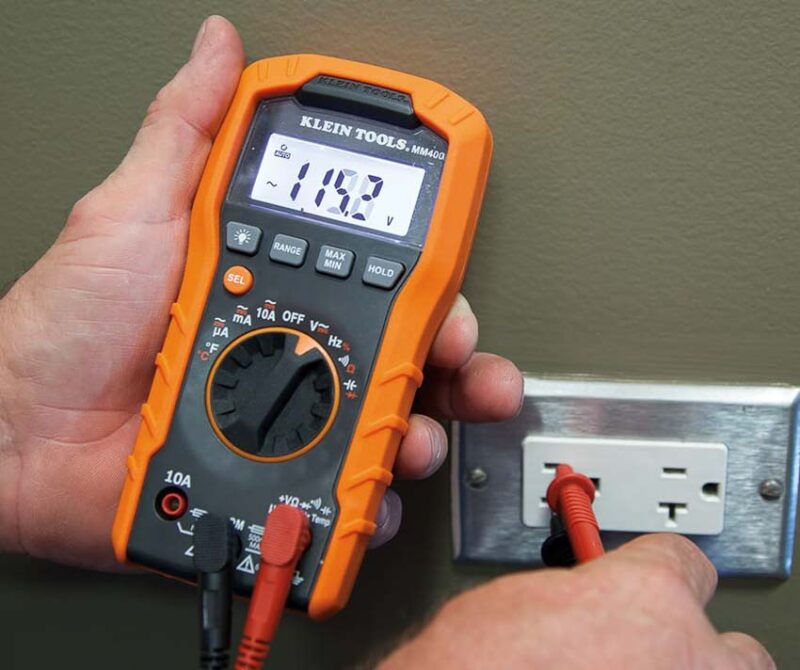
Klein’s multimeter combines great accuracy range and functionality with a reasonable price tag to make it a powerful multimeter for jobs around the house. Along with being able to measure AC and DC voltage up to 600 volts and 10 amps, it’s also capable of measuring capacitance, temperature, and frequency. We also love the fact that it comes with automatic ranging, eliminating any guesswork when setting it up. The MM400 is also one of the tougher multimeters at its price point. Thanks to a rubberized coating on the exterior, it can survive drops of up to 1 meter unscathed.
KEY FEATURES
- Equipped with automatic ranging
- Rugged construction Klein Tools 69149P Electrical Test Kit with Digital Multimeter
- Measures a broad range of values
SPECIFICATIONS
- Max Voltage: 600 volts
- Automatic Ranging: Yes
- Safety rating: CAT III 600V
Price: $51.72
Best Fluke Multimeter
Fluke 117 Multimeter
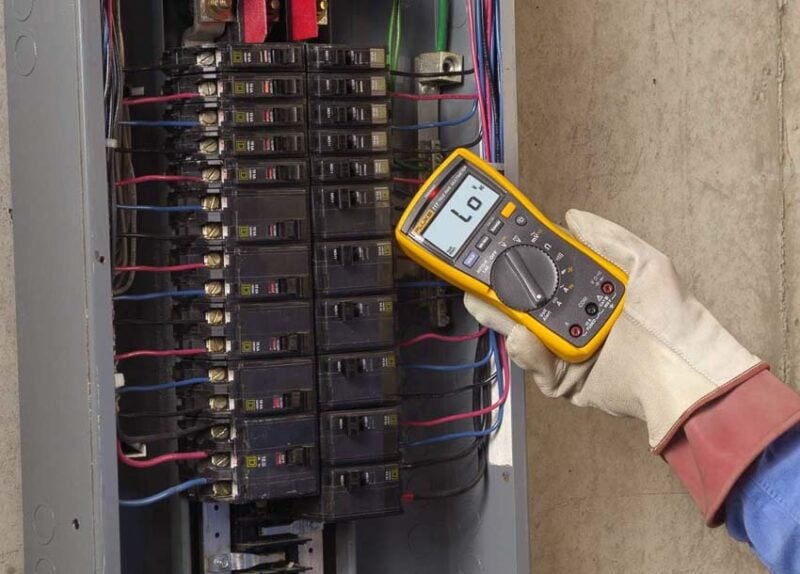
The Fluke 117 doesn’t come cheap, but if you’re a professional electrician and need to take accurate measurements safely, then it’s worth the investment. It can measure resistance, continuity, frequency, and capacitance and uses true RMS and low impedance to produce very accurate measurements. It also has a feature that can automatically determine whether a signal is AC or DC, then select the correct function and range accordingly, so you don’t have to determine the right settings and enter them manually. There’s also a non-contact AC detector that lets you know when a circuit is live, a great safety feature for those who spend their days working around high voltages.
KEY FEATURES
- Equipped with automatic ranging
- True RMS
- Non-contact AC current detector
SPECIFICATIONS
- Max Voltage: 600 volts
- Automatic Ranging: Yes
- Safety rating: CAT III 600V
Price: $253.99
Best Clamp On Multimeter
Fluke 302+ 400AC Clamp Meter
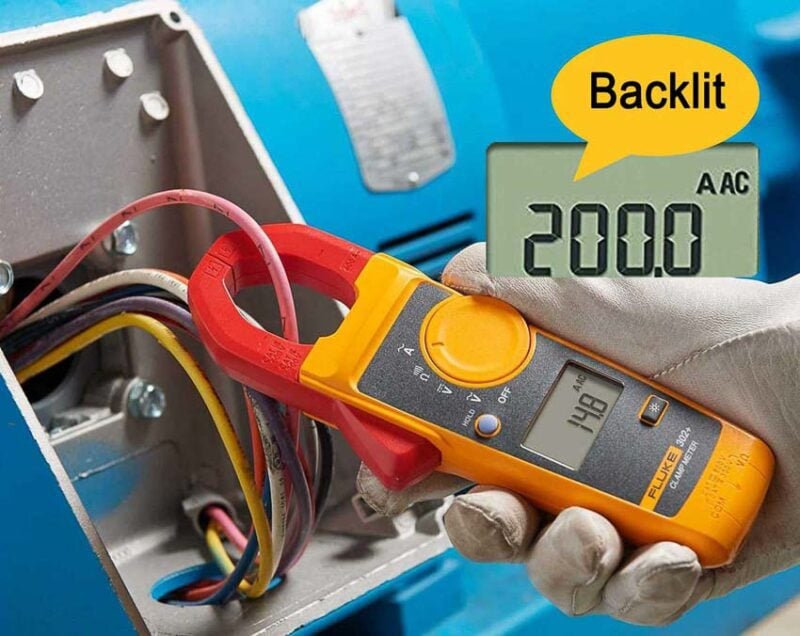
A clamp meter gives you the ability to take quick readings (often in tight quarters) without having to physically connect to the circuit. With its compact size, large activation switch, and backlit display, the Fluke 302+ is one of the top clamp meters. Its small size allows it to take measurements in small spaces, such as a car engine or small electrical box. There’s also an auto-ranging feature that makes it easier to take quick readings and a larger dial that you can manipulate while wearing safety gloves. We also like the 302’s heavy-duty casing, which is tough enough to endure daily use and occasional drops.
KEY FEATURES
- Automatic ranging feature
- Compact size
- Easy-to-use controls
SPECIFICATIONS
- Max Voltage: 600 volts
- Automatic Ranging: Yes
- Safety rating: CAT III 600V
Price: $78.25
Best Multimeter for Electricians
Ideal Electric Commercial Grade Multimeter 61-357
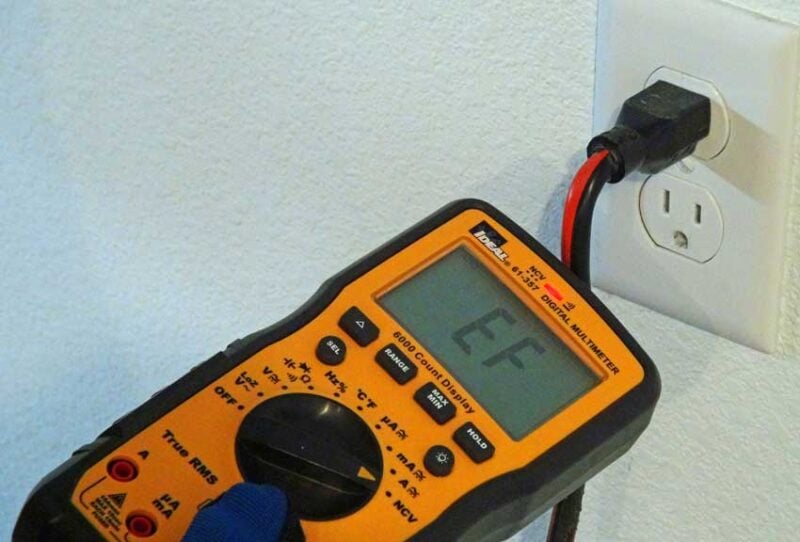
A high degree of accuracy and the ability to work with high voltage makes this multimeter from Ideal Industries a great choice for the professional electrician. Whereas most multimeters top out at 600 volts, this model is capable of measuring voltage up to 1,000 volts. It also measures for a broad range of values, automatically selects range, and uses true RMS to produce very accurate AC readings. There’s also a built-in non-contact voltage detector that lets you know when you’re working near a live current. For those who pine for the older days of analog multimeters, this model produces an analog graph on its display along with standard digital readings.
KEY FEATURES
- Automatic ranging feature
- True RMS
- Displays analog graph with digital readings
SPECIFICATIONS
- Max Voltage: 600 volts
- Automatic Ranging: Yes
- Safety rating: CAT III 1000V, CAT IV 600V
Price: $127.03
Best HVAC Multimeter
Fluke 116 HVAC Multimeter
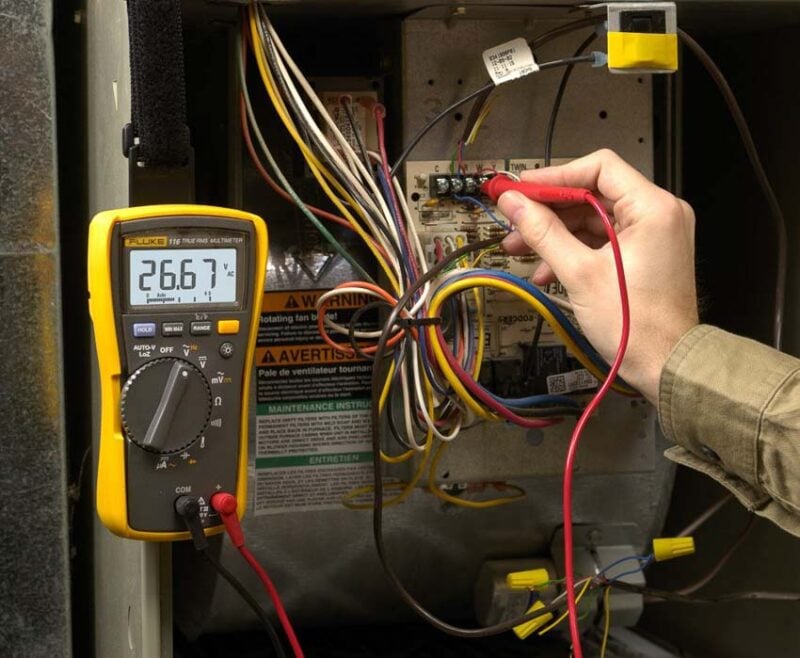
In addition to performing the standard functions most multimeters offer, the Fluke 116 has features that meet the needs of HVAC Pros. With its microamps capability, it can test flame sensors and capacitors, and there’s also a temperature probe that makes it easy to complete HVAC system temperature checks. And, since it has low impedance, it won’t give false readings from ghost voltage like other multimeters can. We also like the large bright backlit LED display that’s easy to read while working in ductwork and the dark places HVAC systems often dwell, such as crawl spaces, basements, and attics.
KEY FEATURES
- Can test flame sensors and capacitors
- Includes a temperature probe
- Low impedance prevents false readings
- Bright backlit display easy to read in dark places
SPECIFICATIONS
- Max Voltage: 600 volts
- Automatic Ranging: Yes
- Safety rating: CAT III 600V
Price: $237.99
Best Multimeter for Cars & RVs
AstroAI Digital Multimeter AM33D
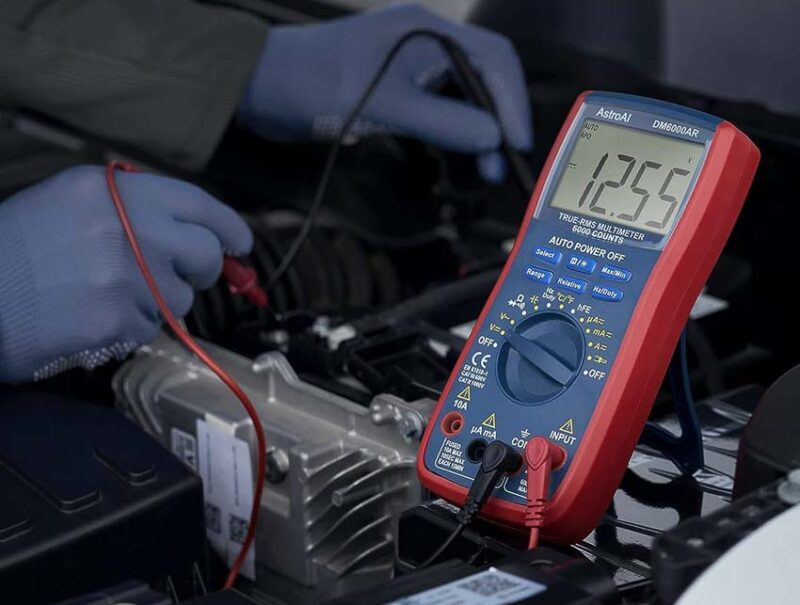
This affordably priced multimeter gives you a lot of electrical measurement bang for your buck. It can measure AC/DC current and voltage, capacitance, frequency, resistance, continuity, and temperature. This makes it a great option for diagnosing problems with household wiring or checking the 12-volt systems in your car or RV. It also comes with a full contingent of accessories for testing voltage, current, continuity, temperature, and resistance. While it does have a wider tolerance than some of the higher-end multimeters out there, it’s more than accurate enough for the types of applications you’ll be using on your vehicles or in your RV.
KEY FEATURES
- Can test a broad range of values
- Easy-to-read digital backlit display
- Comes with test leads and probes
SPECIFICATIONS
- Max Voltage: 600 volts
- Automatic Ranging: No
- Safety rating: TK
Price: $33.99
Best Multimeter for Beginners
Neoteck Pro Auto Ranging Digital Multimeter NT8233D
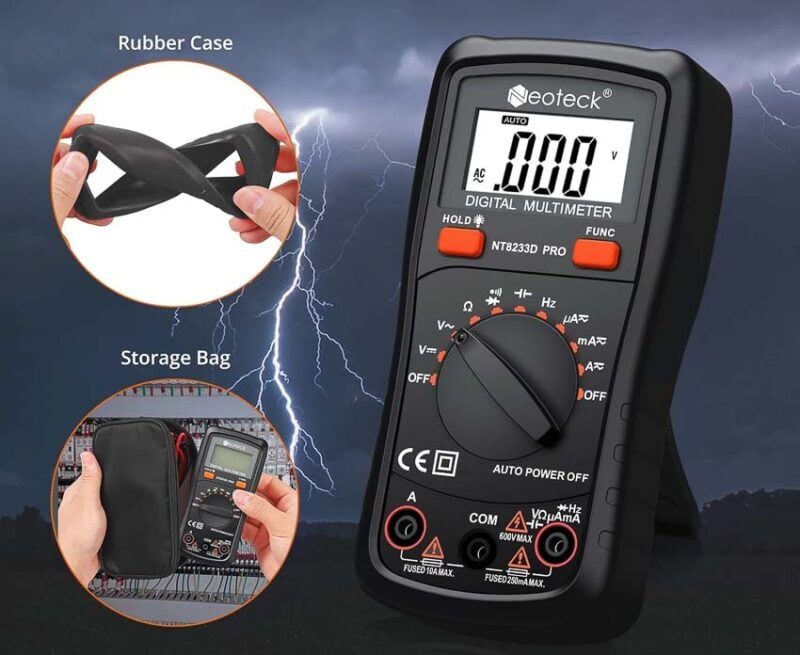
With their strange symbols and many settings, multimeters can be intimidating for newcomers to this type of tool. This affordable model from Neoteck is a great option for multimeter newbies. It can measure a wide range of values, including current voltage, resistance, capacitance, and frequency. Yet, since it’s auto-ranging, beginners won’t need to figure out what range setting to enter. This also means it has far fewer settings to decipher on its dial, making it easier to navigate than some multimeters. The Neoteck also comes equipped with other features beginners will appreciate, including a large easy-to-read backlit display and a tough drop-resistant housing.
KEY FEATURES
- Automatically set range
- Easy-to-use controls
- Large backlit display
SPECIFICATIONS
- Max Voltage: 600 volts
- Automatic Ranging: Yes
- Safety rating: CAT III
Price: $23.99
Best-Selling Multimeters
In addition to the multimeters that we singled out in our list, there are plenty of other models (many from the same brands) that have a lot to offer. Here are more options available at leading retailers.
Amazon
- WeePro Digital Multimeter Vpro850L – $11.88
- Klein Tools Test Kit w/ Digital Multimeter 69149P – $29.99
- Kaiweets Digital Multimeter Voltmeter Smart Electrical Tester KM601 – $34.99
Best-Sellers at Acme Tools
- Milwaukee Electrical Multimeter Combo Kit 2220-20 – $199
- Klein Tools Premium Electrical Test Kit 69355 – $49.97
- Fluke 88V Automotive Multimeter 88-5 – $521.99
Lowe’s
- Fluke Digital Truerms Multimeter 110 PLUS-LW – $159
- Kobalt Non-Contact Digital Specialty Meter DT-926KIT – $30.98
- Craftsman Digital Multimeter 10 Amp 600V CMMT14171 – $64.98
Home Depot
- Klein Tools 600V Digital Manual Ranging Multimeter MM325 – $34.97
- Milwaukee Digital Multimeter 2217-20 – $232.71
- Commercial Electric Pocket Size True RMS Digital Multimeter DMM-8132 – $16.98
Best Multimeters Buying Guide
As is the case with many tools, multimeters are not one-size-fits-all solutions. Indeed, several variables will ultimately factor into how and why you choose the best option for your needs. Let’s explore the core considerations.
Types of Multimeters
Multimeters come in digital, analog, and clamp varieties. Which type is best for you depends on how you plan to use it.
Digital Multimeters
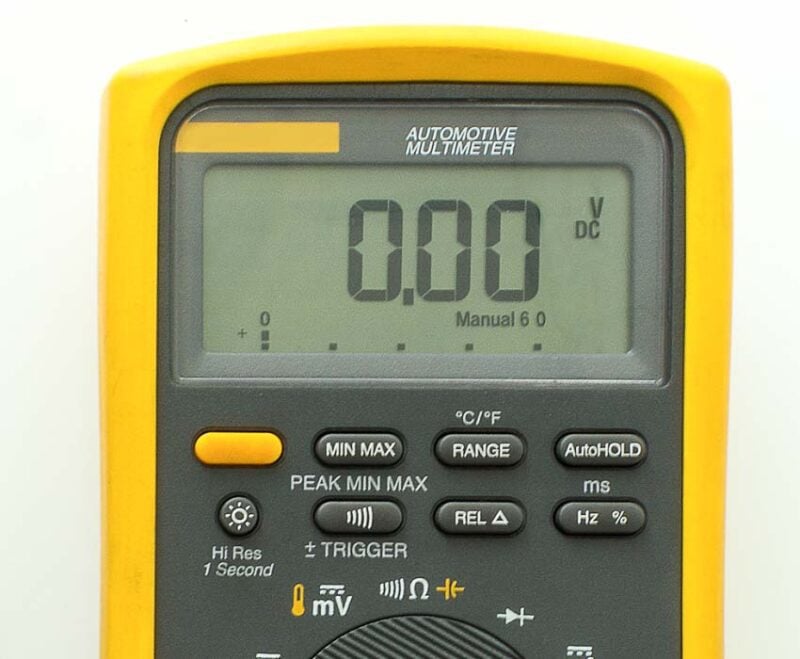
A digital multimeter uses an LCD display to show the current measurement you’re taking. While they may not be more accurate than an analog multimeter, they do provide more precise readings. Digital models provide 5-digit readings and are easier to read than a needle. Moreover, they enable you to freeze a reading on the display or send the data to a computer.
Digital multimeters also have more functions than their analog counterparts, which are limited to measuring voltage, current, and resistance. Digital multimeters, on the other hand, can do all of that plus measure frequency, temperature, and capacitance.
Analog Multimeters
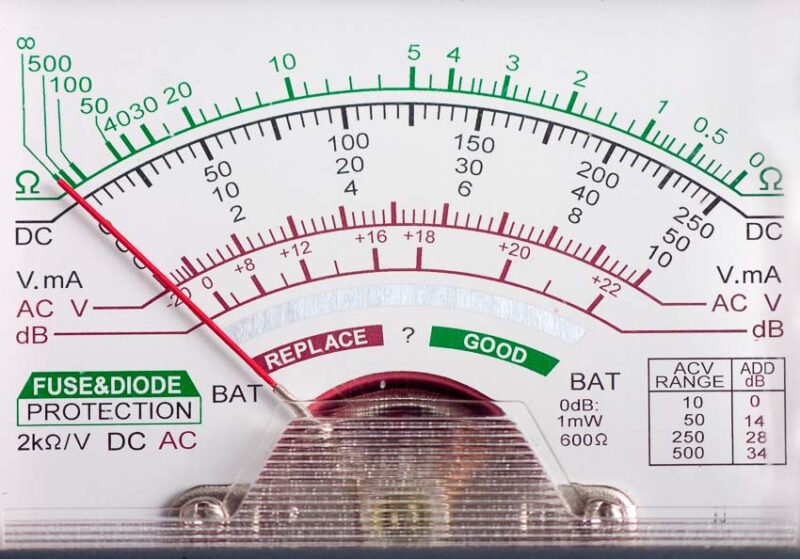
Analog multimeters use a needle and scale to show readings. This design can make it difficult to get precise readings, which is why they’ve largely been replaced by digital models. That said, they do still have one significant advantage. They suffer less interference from electromagnetic activity going on around the multimeter, an element that can throw off digital multimeters.
Clamp Meters
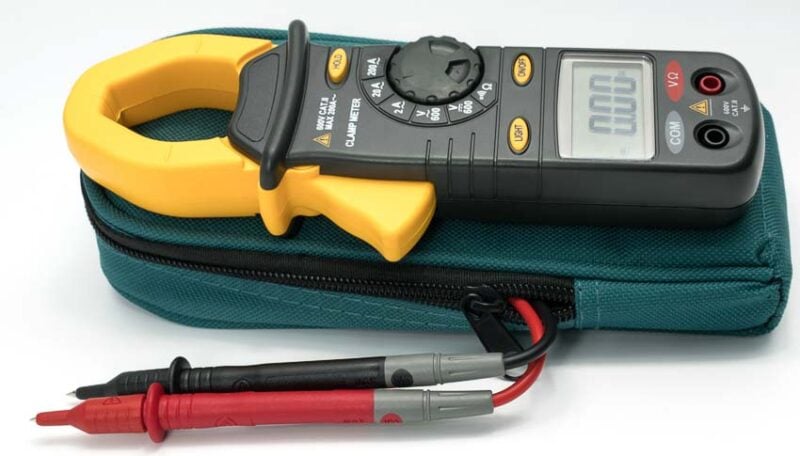
Clamp meters, like multimeters, measure electrical parameters. However, unlike a multimeter, a clamp meter has a round close-pin-like clamp at the end of the tool. The clamp part fits around a live electrical wire to measure the current that’s flowing through it. While clamp meters aren’t as accurate as multimeters, they allow you to measure the current of a live wire without having to break the circuit to do so.
Key Features to Look For
Accuracy and Precision
When choosing a multimeter, pay attention to its margin of error. Accuracy generally varies based on the quality and price of the multimeter. Whereas a budget-priced multimeter’s margin of error might range from +/- 3% a high-end multimeter may have a margin of error of around 0.5% either way or even as little as 0.025%. The margin of error you need depends on what you’re using the multimeter for. While a wider margin of error may be just fine for most home applications, such as checking the voltage of an outlet, you may need a multimeter with a very small margin of error if you’re working with more sensitive electronic equipment.
Precision refers to the multimeter’s ability to take consistent readings repeatedly. Precision is key if you’re taking a series of measurements to determine a pattern or trend that can indicate something faulty.
Voltage Range
A multimeter’s range is a measurement of the minimum and maximum voltage it can read. This range is adjustable to allow you to set the appropriate range for the amount of voltage you are measuring. Some multimeters have an auto-range function that will automatically adjust the range to suit the voltage measurement.
Resistance Range
In addition to allowing you to measure the voltage of a live circuit, you can also measure the resistance of various conductors, ranging from water, to spark plugs, to potatoes. The resistance setting on a multimeter is denoted by the inverted U-shaped symbol that is the Greek letter for Omega. The resistance range on most multimeters is somewhere between 0.1 ohm and 10 kilohm. Some multimeters require you to dial in the range you want, while higher-end models will automatically select the range that’s most appropriate based on the reading.
Display Type
Depending on which type of multimeter you’re using, it will have either a digital or analog display.
A digital display will show the reading in numerical form, typically up to five digits. The display will also show a variety of other information, including measurement units, and mode, range, and function settings. Analog displays use a needle with a meter. Many multimeter displays also have backlights that make the display easier to read in either very bright or very dark conditions.
Build Quality
Since millimeters are carried from place to place to perform tests, they’re susceptible to drops and other abuse. Most multimeters are made from impact-resistant plastics that allow them to survive falls of 4 feet or more. The most rugged varieties have a rubberized molding around their housing that makes them easier to grip and more resistant to impacts.
Price vs. Quality: Striking a Balance
Not surprisingly, you’ll pay more for a higher-quality multimeter with loads of functions. The price range is expansive, ranging from as low as $15 up into the thousands.
Choose a multimeter that makes sense for how you plan to use it.
If you’re an HVAC technician or professional electrician, it’s worth investing in a multimeter that will meet the demands of your job. However, if your needs are more casual (e.g. checking a car battery or the wiring around the house), you don’t have to spend a lot of money. An affordable budget-priced multimeter should more than suffice.
Brand and Warranty
Trusted Names
Choosing a brand that produces quality tools and stands behind its products offers peace of mind and measurable benefits.
Fluke is the industry standard for a reason. It has a solid reputation among electricians, electrical engineers, and other professionals who rely on multimeters every day. Other well-regarded brands include Klein and Tekpower. Likewise, Milwaukee, which is widely known for its power tools, imparts the same standards to its multimeters.
Warranty Considerations
While warranty may not be as crucial for budget-priced multimeters, it is important to consider when investing in a pricier model. Not only will a good warranty provide compensation if the multimeter malfunctions, but it’s also an indication of a well-made product. Many of the top brands, including Fluke, Klein, and Milwaukee, stand behind their products with multi-year warranties.
Multimeter Uses
Basic Electrical Measurements
While multimeters vary in the number of functions they offer, most multimeters allow you to take measurements for voltage, current, and resistance.
Voltage Measurement
A multimeter’s most common application is to test the voltage of a circuit. Using the black and white leads that extend from the multimeter, you can check the current in wall outlets, switches, and breakers. You can also test car batteries and diagnose electrical problems related to a bad alternator, for instance.
Most multimeters allow you to test both direct current (DC) and alternating current (AC) voltages.
Current Measurement
Multimeters can take amperage readings for motors, computers, air conditioners, furnaces, and other devices that draw an electrical load. By connecting the multimeter to an electrical device while it’s off, you can check its amperage value to determine if it’s operating properly.
Resistance Measurement
Multimeters also allow you to measure resistance, which is a measure of the opposition that counteracts the flow of electrical current, by connecting the multimeter’s two probes to opposite ends of the item you want to test. By being able to measure resistance, you can identify faulty wiring or components.
Advanced Functions
Along with the above basic functions, many multimeters, including some budget-price models, allow you to perform more advanced testing on electronics.
Continuity Testing
A continuity test allows you to see if a circuit is open or closed, which is useful if you’re checking for a blown fuse, testing a switch, or searching for a short. During a continuity test, the multimeter sends current through the circuit, checks for resistance, and then emits a beep to indicate if it’s closed.
Diode Testing
Diodes are a type of semiconductor used in a variety of electronics. This component allows current to flow in one direction while restricting it from flowing back in the other direction, changing AC current into DC current. Many multimeters have a function that allows you to test whether a diode is good or bad, meaning it’s either allowing current to flow in both directions or stopping all current from flowing in either direction.
Frequency Measurement
Frequency, when it comes to electronics, refers to the number of times an AC current switches between positive and negative in a second. Some multimeters allow you to measure these cycles to determine if a piece of electrical equipment or machinery is operating properly.
HVAC and Household Uses
A multimeter is also an essential tool for HVAC techs, allowing them to not only test the electrical components in an HVAC system but also test their cooling and heating performance.
Temperature Measurement
Multimeters with temperature probes and thermocouple sensors are useful for HVAC applications. HVAC techs can use them to check temperature readings in ducts, refrigerant lines, registers, and heating elements, helping them to determine if the system is operating properly.
HVAC System Diagnosis
Along with temperature, HVAC techs can also use a multimeter to diagnose HVAC systems that are malfunctioning. For example, they can be used to check an air conditioner’s capacitor to determine if it’s holding the proper charge or to determine if an AC unit has a bad compressor,
Safety Considerations When Using a Multimeter
While multimeters are useful tools, they also often require the user to put their hand within inches of a live circuit, creating a high risk of electric shock. With that in mind, taking measures to lower that risk when using a multimeter is crucial.
Wear Proper PPE (Personal Protective Equipment)
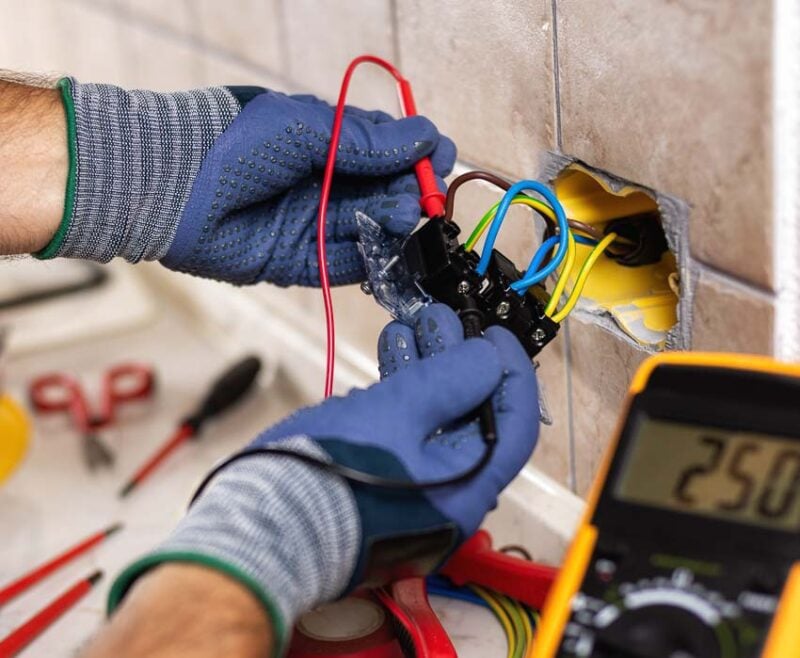
Whether you need to use personal protective equipment when using a multimeter depends on the amount of voltage you’re working with. When working around energized equipment, wear rubber insulating gloves to reduce the risk of electric shock. When working with electrical circuits with voltage greater than 50 volts, make sure to use an insulated rubber mat or electrical hazard work boots along with rubber insulating gloves.
Check Voltage Level Before Testing
One of the biggest causes of electric shocks is from a multimeter that isn’t right for the job. Choose one with the right voltage level and category rating for the job. Using a multimeter rated for less voltage than the equipment you’re testing uses can cause a dangerous arc flash or even cause the multimeter to explode.
Like all electrical measurement tools, multimeters fall into a category designated from I to IV. When choosing a multimeter for the job, make sure it is designed to handle that application by checking its category rating.
Checking Multimeter Condition
Never use a multimeter that’s showing visible signs of wear. Check the test leads to make sure the protective insulation covering them isn’t worn or damaged. Look at the connections between the wires and the test leads or probes for signs of exposed wires and check the wires themselves for fraying. Examine the multimeter’s case for any cracks.
Use Fused Leads
If possible, use fused test leads with your multimeter. Fused test leads and probes have a built-in fuse that provides additional shock protection by cutting off the flow of electricity if there is a dangerous surge in current.
Frequently Asked Questions About Multimeters
What is a multimeter and how does it work?
A multimeter is a tool that can measure a variety of electrical values, including volts, current, resistance, and conductivity. To use a multimeter, you connect probes or leads to a circuit or device to measure the above values.
How do I choose the right multimeter for my needs?
When choosing a multimeter, consider what you’ll be using it for. Make sure the multimeter has the functions needed for those applications. Also, make sure the multimeter’s maximum voltage exceeds the voltage for those applications. The multimeter should also be rated to handle that application.
Are digital multimeters better than analog ones?
Digital multimeters have several advantages over analog models. A digital multimeter is much easier to read accurately compared to an analog meter with a needle. This alone makes it a much more precise instrument than an analog model. Digital multimeters are also more versatile, allowing you to test for frequency, temperature, and capacitance, whereas an analog multimeter is limited to voltage, current and resistance
What safety precautions should I take when using a multimeter?
When using a multimeter, first make sure that you’re using one that has a maximum voltage that’s greater than the voltage you’re testing and has the correct rating for the application. Always make sure the multimeter, test leads, and probes are in good condition. When conducting tests, only use live current when necessary and avoid touching any exposed circuits.
Can I use a multimeter to test the continuity of a wire or a component?
You can use a multimeter to test continuity, assuming, of course, it has that function. You can also test the continuity of switches, various electrical components, fuses, and conductors. Whenever you test for continuity, make sure all power is turned off to the circuit, then attach the multimeter’s leads to the electrical device’s terminals, completing the circuit. A reading of 0 indicates perfect continuity.
Why You Can Trust Pro Tool Reviews
Ever check out a “review” site and you can’t tell if they actually tested anything or if they’re just “recommending” the Amazon top sellers? That’s not us. We won’t recommend anything unless we’d actually use it ourselves, and we don’t really care who the primary retailer is. It’s all about giving you a legitimate recommendation and our honest opinion of each product.
We’ve been in business since 2008 covering tools, writing reviews, and reporting on industry news in the construction and lawn care industries. Our Pro reviewers work in the trades and have the skills and experience to know whether tools can perform well in the field.
Each year, we bring in and review more than 350 individual products. Our team will put our hands on hundreds of additional tools at media events and trade shows throughout the year.
Pro Tool Reviews consults with innovators in the technology and design of tools to gain a broader grasp of where these products fit and how they work.
We work with more than two dozen professional contractors around the United States who review products for us on real job sites. We consult with them extensively on testing methods, categories, and practical applications.
Our site will provide more than 500 pieces of new content this year absolutely free for our readers. That includes objective evaluations of individual tools and products.
The end result is information you can trust because of the editorial, scientific, and real-world professional experience we collectively utilize each and every time we pick up and test a tool.

